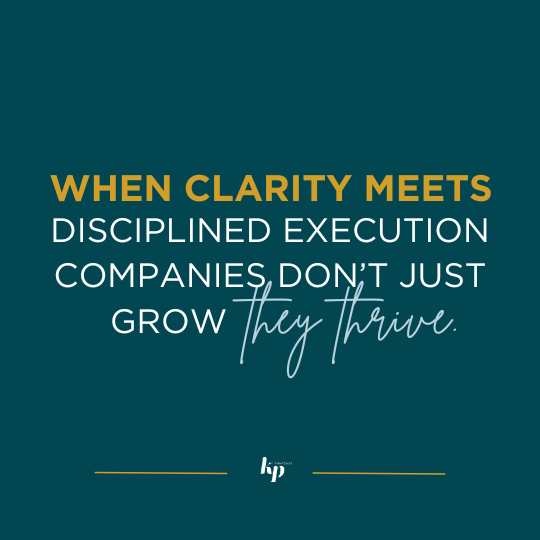When Mark took over as CEO of a mid-sized tech firm, he was confident that his vision for growth was clear. He had outlined an ambitious three-year strategy, presented it to his leadership team, and assumed that execution would follow naturally. But months later, something felt off.

Despite strong talent and significant investments in new initiatives, execution was stalling. Projects weren’t hitting milestones, and employees seemed unclear about how their work connected to the company’s goals. Frustrated, Mark dug deeper. A company-wide survey revealed the harsh truth: only a third of employees could accurately articulate the company’s strategy.
Mark had assumed that setting the vision was enough. But vision without execution is just wishful thinking. He realized he needed to bridge the gap between strategy and action—before the company lost its momentum.
The Five Leadership Shifts That Transformed Execution
Determined to close the gap, Mark focused on five key areas to ensure his company didn’t just understand the vision—but actually executed it.
1. Translating Vision into Measurable Actions
Mark’s first mistake was assuming that vision alone would drive results. He quickly learned that without clear, measurable outcomes, vision is just words on a slide deck.
He partnered with his Chief Operating Officer (COO) to break down the company’s strategic goals into specific, measurable objectives. They assigned key performance indicators (KPIs) to every initiative, ensuring that every department had clear, actionable goals tied directly to the company’s vision.
✅ Lesson learned: If execution isn’t measurable, it isn’t manageable.
2. Communicating Relentlessly
Mark had announced the strategy once—and expected it to stick. But he realized that a single presentation wasn’t enough to drive alignment.
To embed the vision into the company’s culture, he started reinforcing it at every opportunity. Weekly leadership meetings focused on strategic priorities, company-wide town halls highlighted progress, and leaders were tasked with cascading key messages throughout their teams.
The shift was immediate. Employees began speaking the same language, understanding how their work connected to company goals, and moving in the same direction.
✅ Lesson learned: The CEO’s job isn’t just to set the vision—it’s to keep it front and center, always.
3. Inspecting What You Expect
Mark realized he had been too hands-off in the execution process. He had trusted his leadership team but hadn’t created structured accountability.
He implemented regular check-ins, data-driven reviews, and clear accountability mechanisms to ensure execution wasn’t just assumed but actively managed. Leaders were expected to track KPIs, adjust tactics when needed, and demonstrate how their teams were executing against the strategy.
The result? Execution improved, not because of micromanagement, but because of disciplined leadership oversight.
✅ Lesson learned: What gets measured—and inspected—gets done.
4. Removing Execution Barriers
Despite these changes, Mark still saw execution bottlenecks. Teams struggled with slow decision-making, outdated processes, and misaligned priorities.
To fix this, he worked closely with his COO to identify and remove execution barriers—whether that meant simplifying approval processes, reallocating resources, or addressing leadership misalignment.
By eliminating friction points, the company moved faster, execution improved, and leaders could focus on delivering outcomes instead of navigating internal roadblocks.
✅ Lesson learned: The CEO’s job isn’t just to push execution—it’s to remove the obstacles in its way.
5. Creating a Culture of Adaptability
Finally, Mark recognized that execution isn’t static. Market conditions change, customer feedback evolves, and strategies need continuous refinement.
He encouraged his leadership team to stay agile, adapt quickly, and iterate based on real-time data. This shift empowered employees to make informed adjustments, rather than rigidly following outdated plans.
By fostering a culture of adaptability, the company became faster, more resilient, and more competitive.
✅ Lesson learned: The best execution strategy is one that evolves.
From Strategy to Success
A year after Mark’s wake-up call, the transformation was undeniable. Execution had improved, employees were more engaged, and key initiatives were delivering results. But more importantly, Mark had learned a critical leadership lesson:
A CEO’s job doesn’t end with setting the vision. It begins with ensuring it is executed—with clarity, accountability, and adaptability.
Now, ask yourself:
🔹 Are your strategic priorities broken down into clear, measurable actions?
🔹 Are you reinforcing the vision through consistent communication?
🔹 Do you have mechanisms in place to track execution and hold leaders accountable?
🔹 Are you actively removing barriers that slow your company down?
🔹 Is your organization agile enough to adapt to changing market conditions?
Vision without execution is meaningless. But when clarity meets disciplined execution, companies don’t just grow—they thrive.
Is your company executing at the level it should be?